

MT4编程实例:会变色的均线
这里实际上有两条均线,一条红线,一条绿线:
当价格在均线上方时,红线显示,绿线隐藏;
当价格在均线下方时,红线隐藏,绿线显示,
所以看起来就只是一条会变色的均线。
要隐藏一条指标线中的其中一段,也很简单,只要把这一段指标线的值赋为空值(EMPTY_VALUE)就行了。
说说容易,但实际操作的时候,我们又遇到了一个小问题,那就是红绿转换点的“断点”问题,红线和绿线不连续了。图:
这个问题着实困扰了我好一阵,后来终于想通了。
原来,画线的条件是:前后两个时点上都必须有值,才能画出线来。而上图中2和3之间应该画上红线,但在3点位上,红线的值为空,所以,红线画不出来。
要让红线、绿线连续,必须使3点位上,既有绿线值又有红线值,这样2和3之间才能出现红线,红线绿才会连续。
为了做到这一点,我们在给指标线循环赋值的时候:
1、在i 时点上,除了给i 时点赋值,同时还要给i+1时点赋同色值(以上图为例:我们在给3时点赋绿线值时,同时给4时点赋绿线值;在给2时点赋红线值时,同时再给3点赋红线值;这样3时点上就既有红线值,又有绿线值);
2、赋值的顺序为从左向右,即递减循环,以避免前一操作所赋的值被清空。
这样我们的目的就达到了。
下面这是经过测试的源代码
---------------------------------------------------------------------------------------------------
#property indicator_chart_window
#property indicator_buffers 2
#property indicator_color1 Red
#property indicator_color2 Green
extern int 变色均线=18;
double duo[];
double kong[];
int init()
{
SetIndexBuffer(0,duo);
SetIndexBuffer(1,kong);
SetIndexStyle(0,DRAW_LINE);
SetIndexStyle(1,DRAW_LINE);
SetIndexDrawBegin(0,变色均线);
SetIndexDrawBegin(1,变色均线);
IndicatorDigits(Digits);
return(0);
}
int start()
{
double temp0,temp1;
int limit;
int counted_bars=IndicatorCounted();
if(counted_bars<0) return(-1);
if(counted_bars>0) counted_bars--;
limit=Bars-counted_bars;
for(int i=limit; i>=0; i--)
{
duo[i]=EMPTY_VALUE;
kong[i]=EMPTY_VALUE;
temp0=iMA(NULL,0,变色均线,0,MODE_SMA,PRICE_CLOSE,i);
temp1=iMA(NULL,0,变色均线,0,MODE_SMA,PRICE_CLOSE,i+1);
if(iClose(NULL,0,i)>=iMA(NULL,0,变色均线,0,MODE_SMA,PRICE_CLOSE,i))
{duo[i]=temp0; duo[i+1]=temp1;}
else {kong[i]=temp0; kong[i+1]=temp1;}
}
return(0);
}
-----------------------------------------------------------------------------------------------------------
当然,上面这个是以价格在均线上下方为条件的,我们也可以以MACD、KDJ、RSI等指标作为均线变色的条件。我们还可以更进一步,把双色线改为三色线等等
===================================================
语句简要解释如下:
===================================================
#property indicator_chart_window
指标放在主图
#property indicator_buffers 2
设置指标线数组为2个
#property indicator_color1 Red
#property indicator_color2 Green
设置第一条指标线颜色值为Red,第二条颜色值为Green
extern int 变色均线=18;
设立一个自定义变量,允许外部值修改,整数形,变量名为"变色均线",默认值18
double duo[];
设立一个自定义数组,双精度型,名称为duo
该数组在后面用于存储红线数据
double kong[];
设立一个自定义数组,双精度型,名称为kong
该数组在后面用于存储绿线数据
int init()
设立初始化函数init。init为系统规定函数名,函数内容自定义。该函数在指标被加载时运行一次{
SetIndexBuffer(0,duo);
SetIndexBuffer(1,kong);
设置第一、二条指标线的数组为duo和kong
SetIndexStyle(0,DRAW_LINE);
SetIndexStyle(1,DRAW_LINE);
设置第一、二条指标线的样式,线型为连续曲线
SetIndexDrawBegin(0,变色均线);
SetIndexDrawBegin(1,变色均线);
设置第一、二条指标线的最左边的起始划线位置
IndicatorDigits(Digits);
设置指标精确到的小数位数
Digits是当前汇率小数位,日系Digits=2,其他币对Digits=4
return(0);
init函数结束,返回零值
}
int start()
设立触发函数start。start为系统规定函数名,函数内容自定义。当数据变动时,start函数被触发
{
double temp0,temp1;
设立双精度型自定义变量temp0、temp1
int limit;
设立自定义变量limit,整数型
int counted_bars=IndicatorCounted();
设立整数型自定义变量counted_bars,并将IndicatorCounted()的值赋给counted_bars
IndicatorCounted()为缓存数,即已经计算过值的烛柱数
if(counted_bars<0) return(-1);
如果counted_bars值小于零,start函数结束
if(counted_bars>0) counted_bars--;
如果counted_bars值大于零,则counted_bars值减掉1。这是为了配合下一句,以避免limit相差1而出错
limit=Bars-counted_bars;
给limit赋值
Bars为图表中的烛柱数
counted_bars为缓存数,即已经运算过的烛柱数
这样limit的值就是未经运算的烛柱数
这样做的目的是避免重复运算,优化程序
for(int i=limit; i>=0; i--)
循环语句,括号中有三个语句:
第一句int i=limit; 表示循环从i=limit开始
第二句i>=0; 这是循环的条件,如果条件满足则执行大括号中的循环体,如果条件不满足,则中止循环,跳到大括号下面的语句执行
第三句i--,这是循环步调控制语句,每循环一次后执行一次此语句。
i--相当于i=i-1,即i值在原有数值上减少1
{
duo[i]=EMPTY_VALUE;
kong[i]=EMPTY_VALUE;
给数组duo和kong在i位置上赋空值
EMPTY_VALUE:空值
temp0=iMA(NULL,0,变色均线,0,MODE_SMA,PRICE_CLOSE,i);
temp1=iMA(NULL,0,变色均线,0,MODE_SMA,PRICE_CLOSE,i+1);
把均线在i和i+1位置上均线值,分别赋给temp0和temp1
这是为了使后面的语句看起来简洁
if(iClose(NULL,0,i)>=iMA(NULL,0,变色均线,0,MODE_SMA,PRICE_CLOSE,i))
判断条件语句:如果价格高于均线
{duo[i]=temp0; duo[i+1]=temp1;}
判断执行语句:给数组元素duo[i]、duo[i+1]分别赋值
else {kong[i]=temp0; kong[i+1]=temp1;}
如果判断条件不成立,即价格低于均线:则给数组元素kong[i]、kong[i+1]分别赋值}
return(0);
start函数结束,返回零值
}
MT4编程实例:在欧元图上显示英磅的RSI指标
作者:秃鹫来自:韬客外汇论坛https://www.doczj.com/doc/559854327.html,
下面这个图是AUD图上,叠加了英磅的RSI指标。
(当然也可以不叠加,分两个窗口)
从RSI指标图上我们看到,英磅强势,而澳元很弱
下面是指标源码
------------------------------------------------------------------------------------------------------- #property indicator_separate_window
#property indicator_buffers 1
#property indicator_color1 Aqua
#property indicator_level1 30
#property indicator_level2 70
extern int RSI=12;
extern string 商品="GBPUSD";
double ind_buffer[];
int init()
{
SetIndexBuffer(0,ind_buffer);
SetIndexStyle(0,DRAW_LINE,STYLE_SOLID,1);
IndicatorShortName("RSI("+商品+"," +RSI+")");
return(0);
}
int start()
{
int limit;
int counted_bars=IndicatorCounted();
if(counted_bars<0) return(-1);
if(counted_bars>0) counted_bars--;
limit=Bars-counted_bars;
for(int i=0; i ind_buffer[i]=iRSI(商品,0,RSI,PRICE_CLOSE,i); return(0); } ------------------------------------------------------------------------------------------------------- 下面是指标叠加的操作方法: 下面是指标叠加的操作方法: 当然这里用的是RSI指标,别的指标如KDJ、威廉等指标也可以类似操作,只要把上面源码中的取值函数 和参数换一个行了。 ============================================= 语句简要解释如下: ============================================= #property indicator_separate_window 指标放在副图 #property indicator_buffers 1 设置指标线数组为1个 #property indicator_color1 Aqua 设置第一条指标线颜色值为Aqua,即介于蓝绿之间的一种颜色 #property indicator_level1 30 在副图中,30值位置上画一条水平直线 #property indicator_level2 70 在副图中,70值位置上画一条水平直线 extern int RSI=12; 设立一个自定义变量,允许外部值修改,整数型,变量名为"RSI",默认值12 extern string 商品="GBPUSD"; 设立一个自定义变量,允许外部值修改,字符串型,变量名为"商品",默认值"GBPUSD" double ind_buffer[]; 设立一个自定义数组,双精度型 int init() 设立初始化函数init。init为系统规定函数名,函数内容自定义。该函数在指标被加载时运行一次{ SetIndexBuffer(0,ind_buffer); 设置第一条指标线的数组为ind_buffer SetIndexStyle(0,DRAW_LINE,STYLE_SOLID,1); 设置第一条指标线的样式,DRAW_LINE表示连续曲线,STYLE_SOLID表示实心线,1号粗线IndicatorShortName("RSI("+商品+"," +RSI+")"); 设置指标线的显示简称 return(0); 初始化函数结束 int start() 设立触发函数start。start为系统规定函数名,函数内容自定义。当数据变动时,start函数被触发 { int limit; 设立自定义变量limit,整数型 int counted_bars=IndicatorCounted(); 设立整数型自定义变量counted_bars,并将IndicatorCounted()的值赋给counted_bars IndicatorCounted()为缓存数量,即已经计算过值的烛柱数 (注:可能这里解释得不是很准确,大致就这个意思) if(counted_bars<0) return(-1); 如果counted_bars值小于零,start函数结束 if(counted_bars>0) counted_bars--; 如果counted_bars值大于零,则counted_bars值减掉1。这是为了配合下一句,以避免limit相差1而出错 limit=Bars-counted_bars; 给limit赋值 Bars为图表中的柱数 counted_bars为已经赋值的柱数 这样limit的值就是未赋值的烛柱数 这样做的目的是避免重复运算,优化程序 for(int i=0; i 循环语句,括号中有三个语句: 第一句int i=0; 表示循环从i=0开始 第二句i 第三句i++,这是循环步调控制语句,每循环一次后执行一次此语句。 i++相当于i=i+1,即i值在原有数值上增加1 ind_buffer[i]=iRSI(商品,0,RSI,PRICE_CLOSE,i); 此语句为循环体,由于只有一个语句,所以省略花括号 i为图表烛柱的序号,从0开始,右边第1柱序号为0,从右向左递增 iRSI为RSI指标的取值函数 return(0); start函数结束 MT4编程实例:箭头符号(1) 上一篇/ 下一篇2008-03-16 21:49:48 / 个人分类:MT4 查看( 808 ) / 评论( 0 ) / 评分( 0 / 0 ) 作者:秃鹫来自:韬客外汇论坛https://www.doczj.com/doc/559854327.html, 符号是一种断断续续的指标线。在指标线有值区域,指标线显示;在指标线无值区域,指标线隐藏。例如下图:当价格上穿、下穿均线时,均线上出现一个标记符号。 原理也很简单:在上图中,存在二条指标线,一条是均线,另一条是笑脸符号线。 均线在任何位置都有值,所以均线是一条连续的曲线; 当价格上、下穿均线时,符号线被赋予了均线值;而在其他位置上,符号线被赋了空值。所以只是在价格 上、下穿均线的位置上,符号线才有值,才能出现笑脸符号。因为符号线只是个别位置有值,所以符号线仅在个别位置显现。 符号也正好落在均线上,因为符号线值=均线值。如果符号线被赋了别的值,例如(符号线=均线+10点),那么符号水平坐标不变,垂直坐标将是均线上方的10点位置。 源码如下: //====================================================== #property indicator_chart_window #property indicator_buffers 1 #property indicator_color1 Y ellow extern int 均线=10; double mk[]; double temp0,temp1; int init() { IndicatorBuffers(1); SetIndexBuffer(0,mk); SetIndexStyle(0,DRAW_ARROW); SetIndexArrow(0,204); IndicatorDigits(Digits); return(0); } int start() { int limit; int counted_bars=IndicatorCounted(); if(counted_bars>0) counted_bars--; limit=Bars-counted_bars-均线; for(int i=0; i { temp0=iMA(NULL,0,均线,0,0,0,i); temp1=iMA(NULL,0,均线,0,0,0,i+1); mk[i]=EMPTY_VALUE; if(Close[i]>temp0 && Close[i+1] if(Close[i] } return(0); } //源码到此已结束 ============================================= 语句简要解释如下: ============================================= #property indicator_chart_window 指标放在主图 #property indicator_buffers 1 设置指标线数为1条 #property indicator_color1 Y ellow 设置第一条指标线颜色为黄色 extern int 均线=10; 设立一个自定义变量,允许外部值修改,整数形,变量名为"均线",默认值10 double mk[]; 设立一个自定义数组,双精度型 double temp0,temp1; 设立二个自定义变量,双精度型,变量名为temp0、temp1 int init() 设立初始化函数init。init为系统规定函数名,函数内容自定义。该函数在指标被加载时仅运行一次 { IndicatorBuffers(1); 指标线数量为1条 SetIndexBuffer(0,mk); 第一条指标线的数组为mk SetIndexStyle(0,DRAW_ARROW); 第一条指标线的线型为箭头符号 SetIndexArrow(0,204); 第一条指标线的箭头符号为第204种符号,如果换一个编号,那出现的就是另一种符号。箭头符号的编码详见《MT4编程参考》 IndicatorDigits(Digits); 设置指标线的小数位数 Digits=当前汇率的小数位数,如日元叉盘Digits=2,其他币对Digits==4 return(0); 函数结束,返回零值 } int start() 设立触发函数start。start为系统规定函数名,函数内容自定义。当数据变动时,start函数被触发 { int limit; 设立整数型自定义变量limit int counted_bars=IndicatorCounted(); 设立整数型自定义变量counted_bars,并将IndicatorCounted()的值赋给counted_bars IndicatorCounted()为缓存数量,即已经计算过值的烛柱数 if(counted_bars>0) counted_bars--; 如果counted_bars大于零,则将counted_bars的值减掉1 这是为了配合下一句,以避免limit相差1而发生出错 limit=Bars-counted_bars-均线; 这是给limit赋值 Bars为图表中的柱数 counted_bars为已经赋值的柱数 这样limit的结果就是未赋值的烛柱数 再减去“均线”是因为图表最右边段均线无意义 for(int i=0; i 循环语句,括号中有三个语句: 第一句int i=0; 表示循环从i=0开始 第二句i 第三句i++,这是循环步调控制语句,每循环一次后执行一次此语句。 i++相当于i=i+1,即i值在原有数值上增加1 { temp0=iMA(NULL,0,均线,0,0,0,i); 把均线在i位置上的值赋给temp0 iMA:均线取值函数 temp1=iMA(NULL,0,均线,0,0,0,i+1); 把均线在(i+1)位置上的值赋给temp1 mk[i]=EMPTY_VALUE; 给数组mk在i位置上赋空值 EMPTY_VALUE就是空值 if(Close[i]>temp0 && Close[i+1] 条件判断语句。如果在i位置上价格大于均线,并且在(i+1)位置上价格小于均线(即价格上穿均线),则给数组mk在i位置上赋该位置的均线值 Close[i]:在i位置上收盘价。 &&:逻辑运算符“并且” if(Close[i] 与上一句相似 } return(0); start函数结束语句 把所有时段MACD一起显示 上一篇/ 下一篇2008-04-12 14:14:46 / 个人分类:MT4 查看( 625 ) / 评论( 6 ) / 评分( 5 / 0 ) 很久之前就有网友叫我写这个指标,并上传来能把所有时段KDJ一起显示的指标源码,说实在的,当时我第一次看到这个指标时相当吃惊,非常佩服源码作者能有这样的作品,也很希望自己能读懂这段源码增长自己见识,无奈不是专业出身,粗粗看了几遍没能理清这个程序编写思路,由于工作较忙的原因,这件事被搁在一旁。在年终结算工作基本完成的今天,我终于有时间静下心来认真阅读这段程序源码,边阅读边学习,在学习过程中也弥补了不少知识盲点。在弄明白了源码思路之后,感觉眼界大开,对程序构思惊叹不已。思路一通,问题就迎刃而解了。下面是参照All.Stochastic指标而编写的All.MACD指标截图和源码 //=============================================== //这是把所有时段MACD一起显示的指标源码 //由韬客https://www.doczj.com/doc/559854327.html,秃鹫对All.Stochastic指标修改而来//=============================================== #define indicatorName "All MACD" #property indicator_separate_window #property indicator_buffers 4 #property indicator_color1 DarkGray #property indicator_color2 Red #property indicator_color3 Green #property indicator_color4 Y ellow #property indicator_level1 0 #property indicator_levelcolor DimGray extern int FastEMA=12; extern int SlowEMA=26; extern int SignalSMA=9; extern string timeFrames = "M1;M5;M15;M30;H1;H4;D1;W1;MN"; extern int barsPerTimeFrame = 50; extern bool shiftRight = False; extern bool currentFirst = False; extern color txtColor = Silver; extern color separatorColor = Red; int multiple[9]={128,128,64,32,16,8,4,2,1}; double MacdBuffer0[]; double MacdBuffer1[]; double MacdBuffer2[]; double SignalBuffer[]; string shortName; string labels[]; int periods[]; int Shift; int init() { if (shiftRight) Shift = 1; else Shift = 0; barsPerTimeFrame= MathMax(barsPerTimeFrame,15); shortName = "MACD2线3色("+FastEMA+","+SlowEMA+","+SignalSMA+")"; IndicatorShortName(shortName); SetIndexBuffer(0,MacdBuffer0); SetIndexBuffer(1,MacdBuffer1); SetIndexBuffer(2,MacdBuffer2); SetIndexBuffer(3,SignalBuffer); SetIndexStyle(0,DRAW_LINE); SetIndexStyle(1,DRAW_HISTOGRAM); SetIndexStyle(2,DRAW_HISTOGRAM); SetIndexStyle(3,DRAW_LINE); SetIndexDrawBegin(3,SignalSMA); IndicatorDigits(Digits+1); SetIndexShift(0,Shift*(barsPerTimeFrame+1)); SetIndexShift(1,Shift*(barsPerTimeFrame+1)); SetIndexShift(2,Shift*(barsPerTimeFrame+1)); SetIndexShift(3,Shift*(barsPerTimeFrame+1)); SetIndexLabel(0,"MACD"); SetIndexLabel(1,"MACD"); SetIndexLabel(2,"MACD"); SetIndexLabel(3,"Signal"); timeFrames = StringUpperCase(StringTrimLeft(StringTrimRight(timeFrames))); if (StringSubstr(timeFrames,StringLen(timeFrames),1) != ";") timeFrames = StringConcatenate(timeFrames,";"); int s = 0; int i = StringFind(timeFrames,";",s); int time; string current; while (i > 0) { current = StringSubstr(timeFrames,s,i-s); time = stringToTimeFrame(current); if (time > 0) { ArrayResize(labels ,ArraySize(labels)+1); ArrayResize(periods,ArraySize(periods)+1); labels[ArraySize(labels)-1] = current; periods[ArraySize(periods)-1] = time; } s = i + 1; i = StringFind(timeFrames,";",s); } if(currentFirst) for (i=1;i if (Period()==periods[i]) { string tmpLbl = labels[i]; int tmpPer = periods[i]; for (int k=i ;k>0; k--) { labels[k] = labels[k-1]; periods[k] = periods[k-1]; } labels[0] = tmpLbl; periods[0] = tmpPer; } return(0); } int deinit() { for(int l=0;l ObjectDelete(indicatorName+l); ObjectDelete(indicatorName+l+"label"); } return(0); } int start() { string separator; int window=WindowFind(shortName); int k=0; for(int p=0; p { for(int i=0; i { MacdBuffer0[k] = iMACD(NULL,periods[p],FastEMA,SlowEMA,SignalSMA,0,0,i)*multiple[p]; SignalBuffer[k]= iMACD(NULL,periods[p],FastEMA,SlowEMA,SignalSMA,0,1,i)*multiple[p]; double temp=(MacdBuffer0[k]-SignalBuffer[k])*1.3; if(temp>=0) {MacdBuffer1[k]=temp;MacdBuffer2[k]=EMPTY_VALUE;} else {MacdBuffer2[k]=temp;MacdBuffer1[k]=EMPTY_VALUE;} } MacdBuffer0[k] = EMPTY_VALUE; SignalBuffer[k] = EMPTY_VALUE; MacdBuffer1[k] = EMPTY_VALUE; MacdBuffer2[k] = EMPTY_VALUE; k += 1; separator = indicatorName+p; if(ObjectFind(separator)==-1) ObjectCreate(separator,OBJ_TREND,window,0,0); ObjectSet(separator,OBJPROP_TIME1,barTime(k-Shift*(barsPerTimeFrame+1)-1)); ObjectSet(separator,OBJPROP_TIME2,barTime(k-Shift*(barsPerTimeFrame+1)-1)); ObjectSet(separator,OBJPROP_PRICE1,-0.1); ObjectSet(separator,OBJPROP_PRICE2,0.1); ObjectSet(separator,OBJPROP_COLOR ,separatorColor); ObjectSet(separator,OBJPROP_WIDTH ,2); separator = indicatorName+p+"label"; if(ObjectFind(separator)==-1) ObjectCreate(separator,OBJ_TEXT,window,0,0); ObjectSet(separator,OBJPROP_TIME1,barTime(k-Shift*(barsPerTimeFrame+1)-5)); ObjectSet(separator,OBJPROP_PRICE1,0); ObjectSetText(separator,labels[p],9,"Arial",txtColor); } SetIndexDrawBegin(0,Bars-k); SetIndexDrawBegin(1,Bars-k); return(0); } int barTime(int a) { if(a<0) return(Time[0]+Period()*60*MathAbs(a)); else return(Time[a]); } int stringToTimeFrame(string TimeFrame) { int TimeFrameInt=0; if (TimeFrame=="M1") TimeFrameInt=PERIOD_M1; if (TimeFrame=="M5") TimeFrameInt=PERIOD_M5; if (TimeFrame=="M15") TimeFrameInt=PERIOD_M15; if (TimeFrame=="M30") TimeFrameInt=PERIOD_M30; if (TimeFrame=="H1") TimeFrameInt=PERIOD_H1; if (TimeFrame=="H4") TimeFrameInt=PERIOD_H4; if (TimeFrame=="D1") TimeFrameInt=PERIOD_D1; if (TimeFrame=="W1") TimeFrameInt=PERIOD_W1; if (TimeFrame=="MN") TimeFrameInt=PERIOD_MN1; return(TimeFrameInt); } string StringUpperCase(string str) {